The Role of Public Charter Schools in Little Rock
October 16, 2016
John Bacon
CEO, eStem Public Charter Schools
Two types of charter schools
- Open enrollment public charter schools
- Conversion charter schools
What are open enrollment charter schools?
- Public schools
- Tuition free
- Not affiliated with a traditional school district
- Hold a charter (contract) with and are directly accountable to the Arkansas Department of Education
- Provided flexibility from some laws through waivers
- Open to anyone who is a resident of the state of Arkansas
- Admitted through a random, anonymous lottery process
What are conversion charter schools?
- Public schools
- Tuition free
- Affiliated with a traditional public school district
- Generally developed to “turn around†low performing schools
- Provided flexibility from some laws and waivers
- Admission criteria and process for selection of students are determined by the school district
Why do charter schools exist in Arkansas?
From the Arkansas Charter School Act of 1999
The legislative intent of the General Assembly in creating its charter law was to accomplish the following:
- Improve student learning
- Increase learning opportunities for all students, with special emphasis on expanded learning experiences for students identified as low-achieving
- Encourage the use of different and innovative teaching methods
- Create new professional opportunities for teachers
- Provide parents and pupils with expanded choices
- Hold the schools established under this chapter accountable
Key charter school themes
- Accountability
- Transparency
- Choice
- Efficiency
- Innovation
Little Rock Area Charters
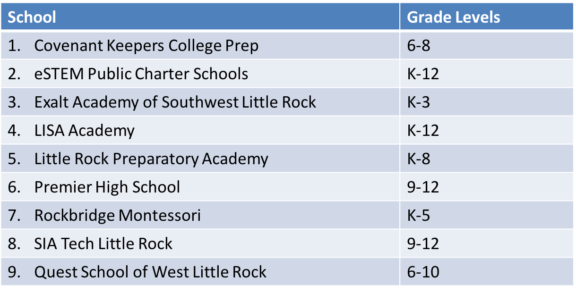
Little Rock Area Charters
Different models to meet diverse needs:
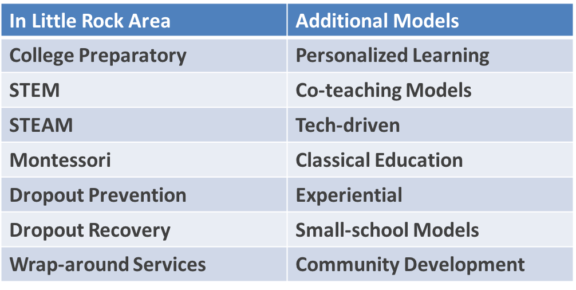
eStem: A Brief History
- eStem Elementary, Middle, and High Schools opened as three separately chartered entities in July of 2008 with 840 students in grades K-9.
- Through the addition of one high school grade per year and an expansion in 2010, the eStem schools reached a maximum capacity of 1,462 students in 2012.
- The first eStem senior class of 84 students graduated in 2012. Four additional classes of students have since graduated from eStem High bringing the total number of graduates to 564.
- In 2013, the three original eStem charters were combined into one charter that was renewed for a ten-year period.
eStem: Demographic Diversity
eStem Public Charter Schools enroll a diverse population of students:
K-12 Enrollment (October 1, 2015)
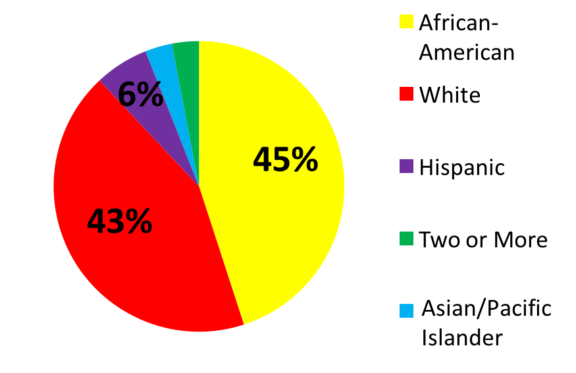
The demographic composition of our schools reflects a greater racial balance than is found in the population of the surrounding area.

eStem: A Record of Success
eStem High’s 436 graduates (2012-2015) accepted more than $14.91 million in scholarships (an average of more than $34,197 per student).
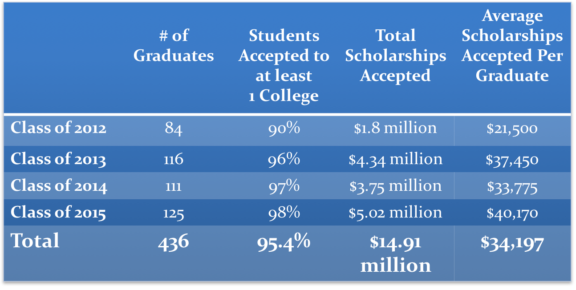
eStem: Innovative Approaches
- Maximization of Resources
- Extended day/year
- Grant program to support innovative project-based learning
- Performance Award/Merit Pay program
- Curriculum
- 26 units required for eStem graduation
- Noble Impact program (Public Service/Entrepreneurship)
- Instruction
- Hands-on science every year beginning at Kindergarten
- Economics infused across the curriculum
- Teacher/Leader development and support
- STEM Residency program
- 90 hours + of professional development offered each year
eStem: Impacting Education on a Larger Scale
Noble Impact program
- Coordinated/participated in High School Startup Weekend
- Created/facilitated Innovate to Educate (i2e) event
- Participating in internship experiences with local businesses and non-profit organizations
- High school students serving as mentors to K-8 students
- Students starting their own businesses and developing an entrepreneurship skill set
*Recently approved by ACE as the Noble Impact program of study
eStem: Substantial Applicant Interest
- Current eStem Enrollment = 1,462 students
- eStem Waiting List = 6,700 students
eStem: Where We Go Next
- Increase enrollment capacity from 1,462 to 3,844 students
- Relocate eStem High School to UALR campus serving grades 10-12 for the 2017-2018 school year
- Restructure current Elementary and Middle Schools to serve grades K-6 (Elem.) and 7-9 (Jr. High) for the 2017-2018 school year
- Open new campuses serving K-6 (Elem.) and 7-9 (Jr. High) at the 400 Shall Street location for the 2018-2019 school year
Academic Performance
2014 ACTAAP Performance Data
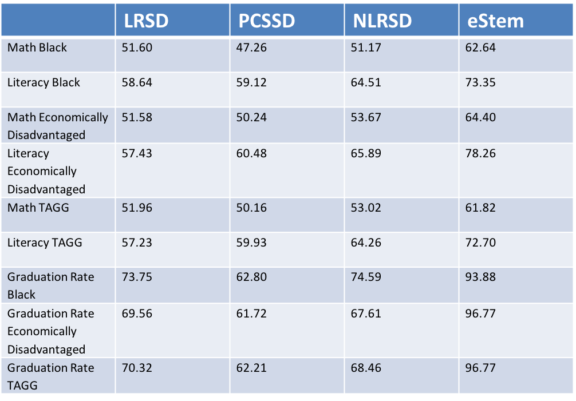
2013 ACTAAP Performance Data
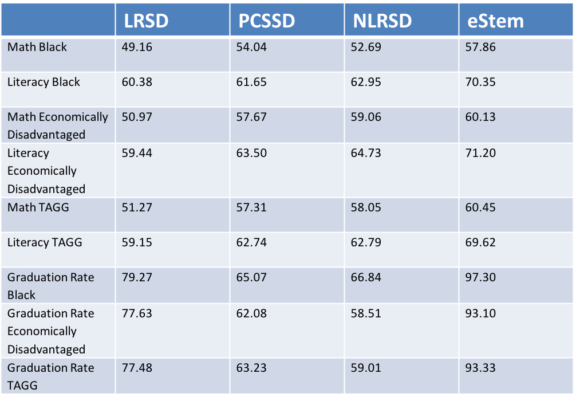
Financial Efficiency
Comparison of per-pupil expenditures

What does all this mean?
- We are spending more money than ever on public education in our community
- Our most disadvantaged students are still struggling
- This applies to students in traditional public schools and public charter schools
- Our community has fractured into three segments:
- Private school families/advocates
- Traditional public school families/advocates
- Public charter school families/advocates
- The state of Arkansas removed local control of the LRSD board in 2015 – three superintendents later, we have yet to see “true change†occur
What do we do now?
- Move beyond our personal/political feelings about public education/charters/school choice
- Focus on what is best for ALL students in our community
- Demand new and innovative approaches that hold potential to improve educational outcomes
- Encourage collaboration between the traditional school districts and public charters in our community
- Pursue flexibility for traditional public schools through waivers that are currently held by public charter schools
- Stop looking for someone to blame for the current state of public education in our community and move toward real solutions
